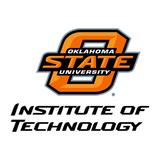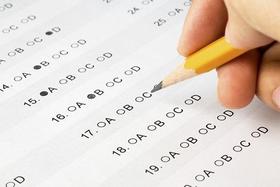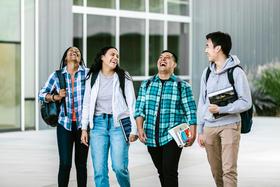- The mission of Connors State College is to continuously provide affordable, accessible and effective learning environments for the lifelong educational needs of the diverse communities it serves.
School Highlights
Connors State College serves 2,307 students (43% of students are full-time).
The college's student-teacher ratio of 18:1 is same as the state community college average of 18:1.
Minority enrollment is 60% of the student body (majority American), which is more than the state average of 56%.
Quick Facts (2025-26)
- Enrollment: 2,307 students
- In-state tuition: $3,563
- Out-state tuition: $8,136
- Student-teacher ratio: 18:1
- Minority enrollment: 60%
- Source: Integrated Postsecondary Education Data System (IPEDS)
Top Rankings
Connors State College ranks among the top 20% of public schools in Oklahoma for:
Category
Attribute
Diversity
School Resources
School Overview
The teacher population of 128 teachers has stayed relatively flat over five years.
Connors State College
(OK) Community College Avg.
Carnegie Classification
Associate's Colleges: Mixed Transfer/Career & Technical-High Traditional
Baccalaureate/Associate's Colleges: Mixed Baccalaureate/Associate's
Institution Level
Less than 2 yrs
At least 2 but less than 4 years
Institution Control
Public
Public
Total Faculty
128 staff
184 staff
School Calendar
Student Body
The student population of Connors State College has grown by 9% over five years.
The student-teacher ratio of 18:1 has increased from 16:1 over five years.
The Connors State College diversity score of 0.73 is less than the state average of 0.76. The school's diversity has stayed relatively flat over five years.
Total Enrollment
2,307 students
1,856 students
Student-Teacher Ratio
18:1
18:1
# Full-Time Students
998 students
712 students
# Part-Time Students
1,309 students
1,144 students
# Enrollment Undergraduate
230 students
248 students
# Full-Time Undergraduate Students
998 students
663 students
# Full-Time Graduate Students
n/a
5 students
# Part-Time Undergraduate Students
n/a
1,058 students
# Part-Time Graduate Students
n/a
14 students
Total Dormitory Capacity
n/a
300 students
% American Indian/Alaskan
27%
8%
% Asian
1%
4%
% Hispanic
7%
11%
% Black
6%
10%
% White
40%
44%
% Hawaiian
n/a
8%
% Two or more races
12%
10%
% Non Resident races
6%
1%
% Unknown races
1%
4%
Diversity Score
0.73
0.76
College Completion Rate (Students who graduate in less than 4 years)
26%
54%
College Completion Rate (Students who graduate in 4 years or more than 4 years)
n/a
15%
Average Graduate Earnings (10 Years)
$33,000
$34,700
Tuition and Acceptance Rate
The public in-state tuition of $3,563 is more than the state average of $3,475. The in-state tuition has stayed relatively flat over four years.
The public out-state tuition of $8,136 is more than the state average of $7,963. The out-state tuition has grown by 8% over four years.
In-State Tuition Fees
$3,563
$3,475
Out-State Tuition Fees
$8,136
$7,963
% Students Receiving Some Financial Aid
99%
88%
Median Debt for Graduates
$12,160
$11,000
Median Debt for Dropouts
$6,945
$5,637
Acceptance Rate
n/a
55%
SAT Reading
n/a
387
SAT Math
n/a
475
ACT Composite
n/a
18
ACT English
n/a
17
ACT Math
n/a
18
Source: 2024 (or latest year available) Integrated Postsecondary Education Data System (IPEDS)
School Notes
- Connors State School of Agriculture came into existence in 1908.The State Board of Agriculture was the school's governing board and the school was named after the Board's first chairman, John P. Connors. Classes were first held in downtown Warner in 1909. In 1911, the present Classroom Building was constructed and the school moved to its present location, one mile west of Warner. Connors State Agricultural College became a fully accredited junior college in 1927. The State Board of Agriculture governed Connors until 1944. That year the Legislature created the Board of Regents for the Oklahoma Agricultural and Mechanical Colleges. This Board then became the governing board of Connors State Agricultural College. In 1967, the Oklahoma Legislature changed Connors' name to Connors State College of Agriculture and Applied Science. The College's name was changed again by the Oklahoma Legislature in 2002 to Connors State College. Connors State College has three campus locations. The main campus is in Warner; a rural, agricultural community located at the junction of Oklahoma Highway 64 and Interstate 40 in eastern Oklahoma. The other two campus locations are located 18 miles northeast of Warner in Muskogee. The Muskogee Downtown campus is located at the intersection of Second and Court Streets. Facilities at Warner Campus includes Administration Building, Beef Testing Center, Biff Thompson Baseball Field, Campus Farm, Carl Westbrook Library Learning Center, Child Development Lab, Classroom Building, Education Building, Equine facilities, Faculty and Student Housing, Fine Arts Building, Holloway Hall, Jacob Johnson Science Building, McClarren Hall, Melvin Self Field House, Russell Hall and Women's Dorm. Connors State College offers program in Agriculture, Business, Communication & Fine Arts, Math & Science, Math, Science, Nursing and Social Sciences. Connors State College fulfills this mission through College and university transfer, Developmental education, Occupational and professional education, Student development services and Workforce/economic development for a global society.
Frequently Asked Questions
How much does Connors State College cost?
Connors State College's tuition is approximately $3,563 for In-State students and $8,136 for Out-State students.
What is Connors State College's ranking?
Connors State College ranks among the top 20% of community college in Oklahoma for: Diversity in US community colleges and Percent of students receiving financial aid.
Recent Articles

The Rise of Technical and Vocational Training in 2025
Explore the 2025 surge in technical and vocational training—enrollment, policy, costs, and why this path is gaining ground for students and parents.

Stackable Credentials: How Community Colleges Advance Careers
Discover how community colleges use stackable credentials to build career pathways, boost earnings, and enable lifelong learning in 2025.

High-Paying Jobs You Can Get with a Community College Degree
Discover top high-paying careers you can launch in 2025 with a community college (associate) degree and high-growth credentials in tech, healthcare and trades.










